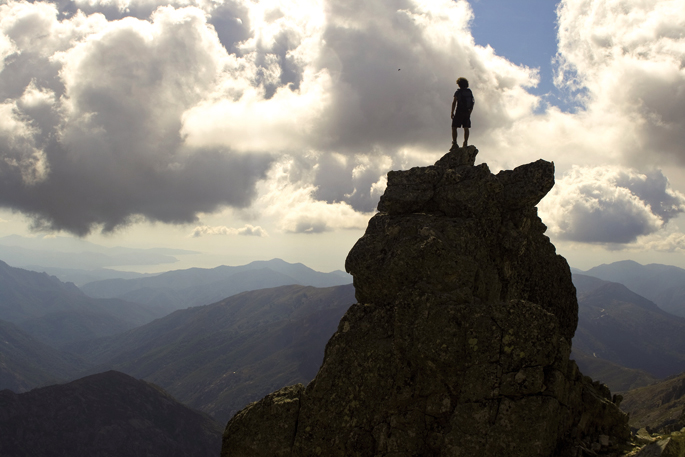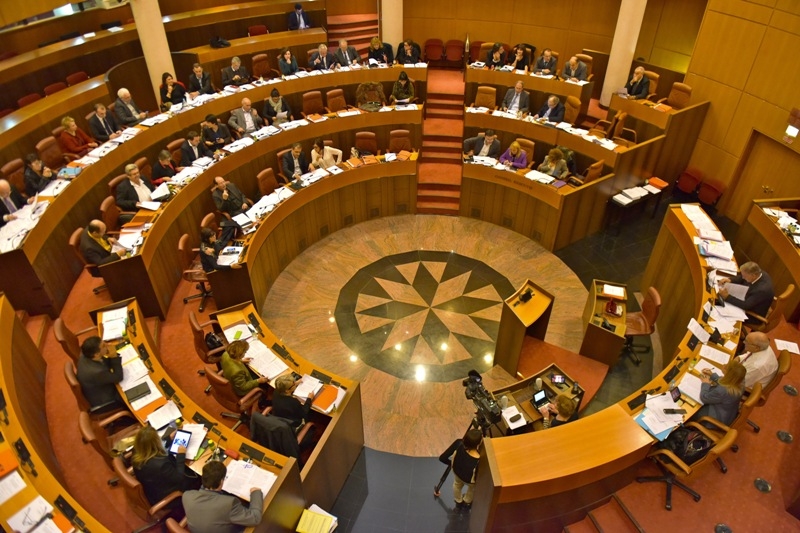Island of the Mountains
- The invincible asterix brought us to Corsica two millennia ago to meet another invincible village. Today, without pretending to repeat the typical clumsy topics, it seems to us that the pride and rebellious identity shown by many of its inhabitants is as real as life itself, and that to a large extent it has been caused by the abrupt orography of this beautiful and wild place.

It can be said, without going into geological details, that Corsica is a part of the Alps which are situated in the centre of the Mediterranean, surrounded by numerous beaches and cliffs, and in the interior of high mountains and forests reminiscent of the continent’s alpine valleys. Because if we were to be placed in some valley of the Rhetoric without knowing where we are, we would swear that we are in some corner of the Alps.
A spectacular mountain range crosses the island from northwest to southeast. More than a hundred summits located more than 2,000 meters above sea level highlight the 2,706 meters of Mount Cinto, covered with snow in most times of the year. Cinto is located less than 30 kilometers from the coast. The relationship between this distance and its height shows us how vertical this central Mediterranean mountain range is.
The naughty orography constantly shapes the history of the island. The Northeast and the South-West were often incommunicado because of the great snowfalls, and sometimes it was impossible to pass from one valley to another. Hard work for invaders. The Corsicans lived mostly in the mountains, they liked it more than the coast, and for many centuries they had been attacked by guerrillas to more powerful armies than them. But on the one hand, what served them to maintain their identity, on the other hand, made the number of births small and the corses divided. This distinction generated ideological, social and inevitably linguistic limits.
Eleven invasions
The history of Corsica has been confusing and curious. As a result, a strong national identity and a determined will for independence has developed in the villagers. The strategic position of the island attracted the attention of many peoples: in almost three millennia, Phoenicians, Greeks, Romans, Vandals, Byzantines, Pisano, Aragonese, Genoveses and, since 1768, French took over the island, leaving the natives a short margin of autonomy and independence between invasions and invasions.
At present, Corsica is suffering from a new invasion, not so belligerent, that it only thinks of visiting a few days or a few weeks before conquering the territory. Tourism is, in fact, the island's main source of income. And it would be even greater if the visiting reception infrastructures were not so limited. This, instead of damaging it, can be beneficial in the long term, as it will prevent the country’s nature from deteriorating greatly, and this is undoubtedly the main value that Corsica has to offer nature to outsiders.
From the sea to the foces, just one step
The ends are amazing in Corsica. You can't get more than 40 kilometers away from the beaches of the temperate Mediterranean, but this space is enough to be able to carry out many activities in nature. A winter skiing day on the slopes of Ghisoni, Vergio or Val D´ese, harsh mountain trips along the GR-20 route that runs from north to south, the descent of canyons in some of the most interesting places in Europe for this sport, and many others, such as diving and other aquatic activities. Given that it is also an opportunity to enjoy the Mediterranean culture or climate, Corsica is an unbeatable tourist destination.
Bastia, the corsiest city
The best place to access the island is Bastia, the capital of the northeast center, and unique between the coastal cities of Corsica. The influence of Genoa is evident both in architecture and in the plot of the streets. Bastia is undoubtedly the most “authentic” city on the Corsa coast, not forgetting that the major coastal cities are built by the invaders. Bastia is not as fastidious as other cities like Ajaccio, but it has the most noble port on the whole island: among the many cafes, retired fishermen walking along the anchored sailboats are found everywhere.
From Bastia we can reach the north of Corsica. It is the region with the smallest population, due to its lesser protection in the face of the vastness of time. A winding road that part of the city allows to surround the peninsula where the Cape Corse is located. By the edge of the spectacular canyons that hide hundreds of small inlets, you can reach a cape covered by genovese towers.
East Coast Resbaladiza
The east of the island is even more abrupt and more spectacular. The cliffs are submerged in the sea and here and there we find fishing villages of a marked Mediterranean character. Along this road we enter the coast of Agriates, a protected coastline of 40 kilometres, one of the greatest natural treasures of the region.
Following the east coast, we will see the long beaches that have nothing to do with the hidden northern slopes. However, the real estate boom suffered by many areas of the Mediterranean coast has not reached this point, at least by such a high percentage. As a result, in many areas you can get off the road and approach the beaches without stumbling upon a large number of people, even in summer.
From this same coast you can access the interior of the island, overcoming several significant ports. It is a singular region, covered by large forests. Chestnut is the protagonist, and from there it has taken its name Gastagniccia, the region that lives around chestnut, a fruit that has a place of honor in its business and in its cuisine. Visiting this valley we will immerse ourselves in an important part of the island’s history, where Pasquale Paoli, one of the main advocates of Corsica’s independence, left much of its heritage.
Continuing south through the dorsal spine of the island, we meet the city of Corte. The real heart of Corsica, surrounded by mountains and situated at the confluence of the Restonica and Tavignano rivers. The Court was the capital of the Independent Corsica during the government of Paoli, between 1755 and 1769. In that year, the French defeated the corsican troops in the battle of Pontenuovo.
Cannons of Restonica
It is located in a privileged cutting place: Following the course of the Restonica River, we enter the heart of the most steep and spectacular mountains on the island. Of the fourteen kilometers of this mountain river, most are located within the Cañones de la Restonica, where there are numerous waterfalls. The river loses 1,300 meters high on this route, and its course has created the most beautiful and savage valley in Corsica. Being the watchpoint of the corsican mountains, each year it receives the visit of thousands of people who go for quiet walks, others to practice delicious mountain sports.
Returning to the coast, we will cross the mountain range that divides the island to reach the capital of the southwest of Corsica, Ajaccio. We leave behind the high mountains that are visible from the city and offer a curious picture during the winter: Snowy sky over the Mediterranean. The streets, monuments, states, constantly remind us that the emperor Napoleon Bonaparte was born in Ajaccio on August 15, 1769, when the French finally took over the island.
Bonifaccio, south end
Following towards the south end, leaving behind the Alpine landscapes and passing through an environment of marked Mediterranean character, we will pass through Popiano and Sartène until we reach Bonifaccio. The city is situated in an admirable situation over the Mediterranean, on the top of a long cliff, from which the strait of the same name can be seen. The Magdalene Archipelago and the island of Sardinia are easily recognizable from the viewpoints of Bonifaccio, and on the sunny evenings you can see the dolphin flocks that cross the strait from the city walls.
Korsikako legebiltzarkideek ezin dute Korsikako Asanblean korsikeraz hitz egin, Bastiako Auzitegiaren 2023ko epai baten arabera. Ebazpen horri helegitea jarri zion Asanbleak, baina debekua berretsi du orain auzitegi berak. Epaiak tokiko beste hizkuntzei eragiten diela ohartarazi... [+]
Irulegiko Irratiko Sakonean emankizunaren hirugarren saioan Korsikako nazio askapen mugimendua izan dute hizpide, Marseillako presondegian Yvan Colonna FLNC Korsikako Nazio Askapen Fronteko militante eta preso politikoak bizia galdu zuenetik hilabetera.

























